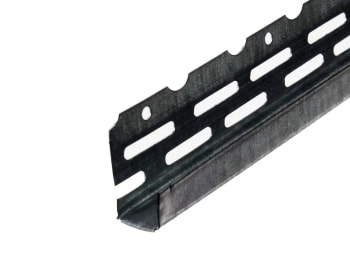Plasterboard Edge Bead
(2 Products)Edges, arrises and abutments need not be difficult to form. Plasterboard Edge Bead simplifies the rendering and plastering process by enclosing plasterboard edges in a protective steel enclosure, reinforcing and strengthening them as a result. Not only do edge beads minimise potential chipping, but they also allow for sharp, neat corners to be plastered easily.
What Is A Plasterboard Edge Bead?
Edge beads create a defined square edge for external render systems.
With a solid hooked corner and an edge with either mesh or perforated wings, their primary purpose is to reinforce plasterboard edges against different building materials, such as a wooden door frame, an exposed stone wall, or a suspended ceiling.
To prevent water from entering, a silicone sealant is typically applied along the return or back edge of the edge bead.
Stop beads can also help you add design elements to your render, such as 'picture frames' or decorative feature panels.
Where Are Plasterboard Edge Beads Used?
- Window and door frames
- Soffits
- Copings
- Other claddings or building fabrics
Plasterboard Edge Bead Benefits
- Provides precise corners for plastering over
- Available in a range of sizes, both width and length
- For internal thin-coat plaster application
- Envelopes the edge in a protective steel enclosure to strengthen the edge
- Perforated wing profile provides a key to prevent cracking
- Can be fixed via dabs or masonry nails of similar material
- Features fixing holes to accommodate a standard plasterboard nail
Frequently Asked Plasterboard Edge Bead Questions
Frequently Asked Questions About Plasterboard Edge Beads
How Do I Install Edge Beads on Plasterboard Edges?
Edge beads differ from angle beads in that they should be applied to plasterboard before the panels are affixed to either a stud wall or solid wall.
You can use tin snips to custom cut them to size, as needed.
How To Cut Plasterboard Edge Beads?
Edge beads can be cut to size with a variety of tools. We recommend using tin-snips, hacksaws or aviation cutters.
What Does A Galvanised Edge Bead Mean?
Galvanising is a common manufacturing process applied to edge beads in which steel or iron is coated with zinc to protect it from rusting, offering enhanced corrosion resistance.
The most popular method of galvanising is hot-dip galvanising.
What Is The Difference Between An Edge Bead & A Corner Bead?
Edge beads create a defined square edge for external render systems. With a solid hooked corner and an edge with either mesh or perforated wings, their primary purpose is to reinforce plasterboard edges against different building materials, such as a wooden door frame, an exposed stone wall, or a suspended ceiling.
Edge beads differ from angle beads in that they should be applied to plasterboard before the panels are affixed to either a stud wall, suspended ceiling or solid wall with plasterboard adhesive.
Edge beads can be used for a straight edge at the end of a run of plasterboard, or where a raised/recessed feature is necessary.


